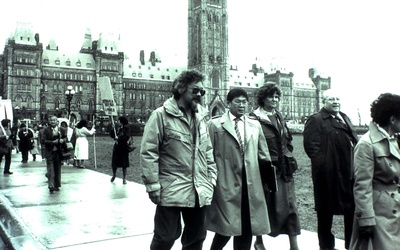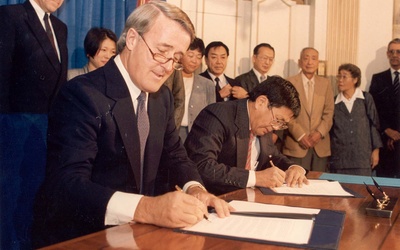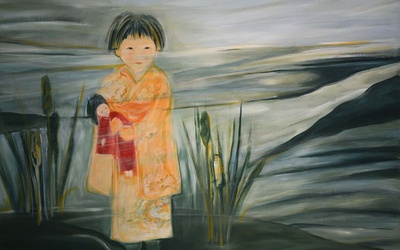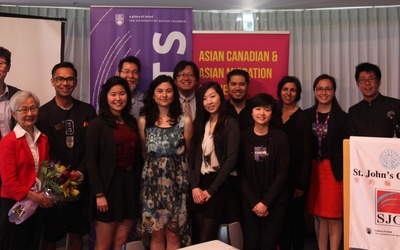Canadian Nikkei Series
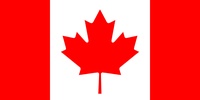
The inspiration for this new Canadian Nikkei interview series is the observance that the gulf between the pre-WW2 Japanese Canadian community and the Shin Ijusha one (post-WW2) has grown tremendously.
Being “Nikkei” no longer means that one is only of Japanese descent anymore. It is far more likely that Nikkei today are of mixed cultural heritage with names like O’Mara or Hope, can’t speak Japanese and have varying degrees of knowledge about Japan.
It is therefore the aim of this series to pose ideas, challenge some and to engage with other like-minded Discover Nikkei followers in a meaningful discussion that will help us to better understand ourselves.
Canadian Nikkei will introduce you to many Nikkei who I have had the good fortune to come into contact with over the past 20 years here and in Japan.
Having a common identity is what united the Issei, the first Japanese to arrive in Canada, more than 100 years ago. Even in 2014, it is the remnants of that noble community that is what still binds our community today.
Ultimately, it is the goal of this series to begin a larger online conversation that will help to inform the larger global community about who we are in 2014 and where we might be heading to in the future.
Stories from this series
Following the ‘Wabi Sabi’ Way With Vancouver Artist Haruko Okano - Part 1
Feb. 15, 2016 • Norm Masaji Ibuki
On April 2nd, there will be a national “Japanese Canadian Art and Artists Symposium” at the Toronto Japanese Canadian Cultural Centre, the last one was in Vancouver in 1996. The one-day event will feature keynote speeches by two important veteran Canadian Nikkei artists: Vancouver’s Haruko Okano and Grace Eiko Thomson of Winnipeg who now resides in Vancouver. Organizer Bryce Kanbara says: “The Japanese Canadian (JC) artist community is diverse with established and emerging artists, offspring of mixed marriage who grew …
Art Miki: Canadian Redress Leader and Human Rights Champion - Part 3
Jan. 14, 2016 • Norm Masaji Ibuki
Read Part 2 >> Why is the NAJC still relevant today? The NAJC has an important role to play especially as a human rights watchdog and in helping the local community organizations survive. Many are having difficulty in finding leaders and volunteers to maintain the organization. The NAJC can provide resource and monetary assistance for leadership programs, recruiting on volunteers and youth. Unless the NAJC takes a more forward approach in assisting local organizations they will eventually fold and then …
Art Miki: Canadian Redress Leader and Human Rights Champion - Part 2
Jan. 13, 2016 • Norm Masaji Ibuki
Read Part 1 >> Going back to the pre-Redress days then, can you trace your involvement with the Japanese Canadian community in Winnipeg and beyond? When and how did it begin? Who were the leaders back in those early days? My leadership began early. When I was 15, I organized a hockey team in our area of the city that was very poor. I coached hockey for a number of years and enjoyed organizing other sports such as baseball and …
Art Miki: Canadian Redress Leader and Human Rights Champion - Part 1
Jan. 12, 2016 • Norm Masaji Ibuki
When it comes to our Canadian Nikkei heroes, Art Kazumi Miki, the National Association of Japanese Canadians (NAJC) president from 1984 to 1992 who led the Redress movement on to victory on September 22, 1988, ranks amongst the top. As I read through Art’s personal story yet again, I am struck by how close Canadian Nikkei once were when we lived in our coastal British Columbia communities: coming from the same prefectures, sharing culture and language, struggles and victories. The …
Koko and Toru's Art Show at the Langham Hotel in Kaslo, BC
Sept. 25, 2015 • Norm Masaji Ibuki
“To discourse on the meaning and symbolism of the work is counterproductive and redundant as the work is the statement. The concepts and meaning lie in those very things that cannot be expressed with words. Simply empty the mind of preconceived notions and take the time to examine each work closely.” —Sculptor Toru Fujibayashi from the Regeneration exhibition booklet Two senior Canadian Nikkei artists Tsuneko “Koko” Kokubo, 78, born at the Fisherman’s Hospital in Steveston and Toru Fujibayashi, 73, …
Yonsei Carolyn Nakagawa and UBC’s Asian Canadian and Asian Migration Studies program - Part 2
Sept. 17, 2015 • Norm Masaji Ibuki
Read Part 1 >> What is it like to be a young Nikkei in BC these days? You know, I’ve met a few other Japanese Canadians at UBC, just by chance, who mostly come from other parts of Canada, and to hear them talk about their families really drives home the importance of BC to our heritage - I’ve heard them say it’s like “returning to the homeland” - the homeland being Vancouver, not Japan. It’s momentous for a Japanese …


